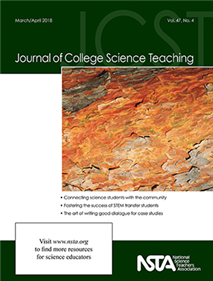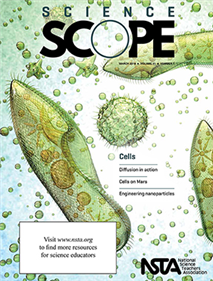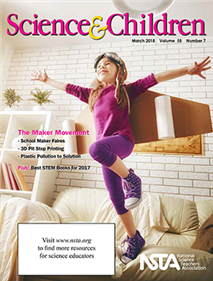All Resources
Journal Article
Students’ Understanding and Perceptions of Assigned Team Roles in a Classroom Laboratory Environment
Using a cooperative learning framework in a quantitative reasoning laboratory course, students were assigned to static teams of four in which they adopted roles that rotated regularly. The roles included: team leader, protocol manager, data recorder,...
Journal Article
In this exploratory case study, the authors consider how students in an undergraduate biochemistry class engaged in the process of argumentation within an inquiry-oriented learning environment to investigate a chemical mechanism in a particular part ...
Journal Article
Point of View: The Professional Science Master’s Degree at Twenty
This column shares reflections or thoughtful opinions on issues of broad interest to the community. This issue discusses Professional Science Master’s degree programs. ...
Journal Article
Inquiry methods have been successful in improving science literacy in students of all ages. Model-Based Inquiry (MBI) is an instructional model that engages students in the practices of science through the collaborative development of scientific mode...
Journal Article
Case Study: Putting Words in Their Mouth: Writing Dialogue For Case Studies
This column provides original articles on innovations in case study teaching, assessment of the method, as well as case studies with teaching notes. This issue discusses dialogue writing guidelines most relevant to case writing....
Journal Article
Could “The Martian” Really Have Grown Potatoes for Food?
Separate science fiction from fact....
Journal Article
Engineering Nanoparticles for the Body
Design a nanoparticle that can travel through a blood vessel....
Journal Article
Cell Modeling Students Can Really Get Into
Use a real-world scenario to engage in the scientific practice of collecting, analyzing, graphing, and interpreting data....
Journal Article
Classic Lessons 2.0: Diffusion in Action
This column shares updated perennial classroom favorites. Investigating the surface area–to-volume ratio in cells....
Journal Article
Integrating Technology: Mapping Digital Game Analogies to Science Instruction
This column shares how teachers use technology for assessment, student learning, or classroom management. This article describes an instructional sequence that shows teachers how to use analogy mapping techniques with the Ruby Realm game....
Journal Article
From the Editor’s Desk: Sparking Student Interest in Hidden Worlds
Science Scope’s editor shares thoughts regarding the current issue....
Journal Article
This column highlights formal and informal science research projects that students can join and contribute to by gathering and sharing data. Citizen science for 21st-century naturalists with the iNaturalist app....
Journal Article
Disequilibrium: Sensory Illusions
This column shows how to use discrepant events to confront misconceptions. The use of optical illusions in the classroom helps students understand that the brain may process reactions based upon a previously learned context, even if the context resul...
Journal Article
Listserv Roundup: Interactive and Digital Notebooks in the Science Classroom
This column shares recent conversations taken from the NSTA listserv community about current science education topics. Last month, NSTA listserv members shared effective note-taking strategies for science students. This month’s column focuses on an...
Journal Article
Science For All: Making Science Memorable
This column shares strategies for increasing student engagement. Memorization techniques for the middle school student....
Journal Article
Teacher To Teacher: Scaffolds for Scientific Explanations
This column provides practical advice from your peers. This month provides an example of an activity that guides middle school students through the formation of a scientific explanation....
Journal Article
Scope on the Skies: Motions of the Earth and Beyond
This column focuses on astronomy throughout the year. This issue discusses rotational speed and visible planets....
Journal Article
This event blends Next Generation Science goals with the concepts of the Maker Movement....
Journal Article
Second graders turn knowledge into action as they engineer solutions for a real-world problem in a school makerspace....
Journal Article
An integrated payload design challenge provides an authentic maker experience....
Journal Article
Editor’s Note: Making Sense of Makerspaces
Science and Children’s editor shares thoughts regarding the current issue....
Journal Article
Guest Editorial: Elementary Engineering: What Is the Focus?
An opinion piece about elementary engineering....
Journal Article
The Early Years: Open-Ended Maker Projects
This column discusses resources and science topics related to students in grades preK to 2. This issue describes how children use available materials to make structures of their own design....
Journal Article
Formative Assessment Probes: Uncovering “Maker” Ideas About Sound
This column focuses on promoting learning through assessment. This issue discusses the Making Sound probe....
Journal Article
Teaching Through Trade Books: The Force Is With You (or Against You)
This column includes activities inspired by children’s literature. This month through the use of playground equipment and common toys, students investigate force, energy, and motion in engaging ways....
Journal Article
The Poetry of Science: Let’s Make a Robot
Building literacy in playful, meaningful ways. This month robotics and trial-and-error in science is discussed....
Journal Article
Teaching Teachers: Designing an NGSS Learning Pathway
This column enhances the repertoire of preservice and inservice teachers. How informal institutions can help teachers implement the NGSS...
Journal Article
Methods and Strategies: Equity and the Maker Movement
Integrating children’s communities and social networks into making...
Journal Article
Science 101: Why Do Helicopters Always Have Two Blades, and How Does That Help Cats?
This column provides background science information for elementary teachers. This issue discusses torque....
Journal Article
Science 102: A Faucet Phenomenon
This column shares exercises to challenge content knowledge. This issue presents a new challenge and answers the Tricky Numbers challenge from last month....
Book Chapter
In this lab investigation, students are introduced to the disciplinary core ideas of (a) The Universe and Its Stars and (b) Earth and the Solar System as they develop a model that explains the underlying cause of the lunar cycle. Included are the Tea...
Book Chapter
In this lab investigation, students are introduced to the disciplinary core ideas of (a) The Universe and Its Stars and (b) Earth and the Solar System as they develop a model that explains seasonal average temperature change. Included are the Teacher...
Book Chapter
In this lab investigation, students are introduced to the disciplinary core ideas of (a) The Universe and Its Stars and (b) Earth and the Solar System as they explore the role that gravity plays in the motion of objects within the solar system. Inclu...
Book Chapter
In this lab investigation, students apply the disciplinary core idea of The Universe and Its Stars to identify exoplanets that may support life. Included are the Teacher Notes, Lab Handout, and Checkout Questions for the lab, in addition to the book�...
Book Chapter
Lab 5: Geologic Time and the Fossil Record
In this lab investigation, students are introduced to the disciplinary core idea of The History of Planet Earth as they identify major extinction and diversification events that happened during the last 650 million years of Earth’s history. Include...






